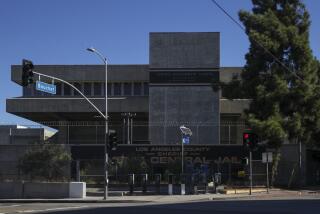Quake risk is found at nuclear lab
- Share via
A big earthquake and resultant fire could trigger potentially deadly releases of radioactive materials from Los Alamos National Laboratory in New Mexico due to “major deficiencies” in the nuclear weapons lab’s safety planning, federal safety experts warned Tuesday.
The warning from the Defense Nuclear Facilities Safety Board was sent to Energy Secretary Steven Chu, urging him to “execute both immediate and long-term actions.”
A spokeswoman for the National Nuclear Security Administration, a part of the Energy Department, said, “We are currently evaluating the board’s recommendation and preparing a formal response.”
The statement also said a number of new safety measures have been added in recent years.
The lab, atop a mesa west of Santa Fe, is the nation’s primary plutonium fabrication facility for nuclear weapons and is believed to house thousands of pounds of plutonium at a complex known as TA-55.
In the course of designing a new building near the plutonium facility, engineers discovered that a previously known fault has the potential for causing far greater ground movement than they had calculated.
The board, an independent federal agency that oversees the nation’s nuclear weapons plants, described the lab’s “safety strategy” as “flawed.”
The issue has bounced around for at least one year and possibly two years, a period when federal safety regulators grew increasingly impatient with the Energy Department’s slow response, according to Peter Stockton, an investigator for the watchdog group Project on Government Oversight.
Energy officials were pressuring the safety board as recently as this week to delay their recommendation, arguing that the situation was not dire enough to issue a public warning, so that they could prepare a news release, Stockton said.
But within the laboratory, it appears that senior nuclear weapons managers are weighing the potential to move some plutonium out of TA-55 -- a costly and technically difficult remedy, he added.
The safety board’s analysis found that in the worst-case scenario, a fire could release so much airborne plutonium that a person on the boundary of the lab would get a dose of radiation -- potentially many thousands of times greater than a chest X-ray -- that could be fatal in weeks, according to individuals knowledgeable about the study.
The danger involves the lab’s hundreds of glove boxes, which are enclosed structures used to safely work on radioactive materials. The projected ground movement in a quake could be enough to topple the boxes.
Some of the glove boxes are quite large, containing furnaces to cast plutonium and machining equipment to form it.
If a glove box were to topple over while a furnace inside was melting plutonium, it could create an uncontrollable fire, according to the safety analysis.
Exactly how much plutonium is stored in the vaults at Los Alamos is classified, but the analysis assumes all of it would be vaporized in a massive fire and then drift off site.
Some of the lab’s closest neighbors are a trailer park and an Indian reservation.
In its statement, the National Nuclear Security Administration said it had approved a new safety analysis that identified the need for additional upgrades.
Though that analysis concluded that the lab is currently safe, it also found that a more sophisticated examination was required of “all the relevant hazards in a seismic event.”
Meanwhile, the lab, which is operated by a consortium that includes the University of California, said it has completed a number of actions this year to improve fire safety at the facility, including installing higher-temperature ventilation filters, adding manual fire extinguishers in many areas and putting plutonium into containers that can survive an accident.
“Protecting the health and safety of our employees, the public and the environment while conducting operations all across the laboratory, particularly at the plutonium facility, TA-55, is our primary concern,” the lab said.
--
ralph.vartabedian @latimes.com
More to Read
Sign up for Essential California
The most important California stories and recommendations in your inbox every morning.
You may occasionally receive promotional content from the Los Angeles Times.











